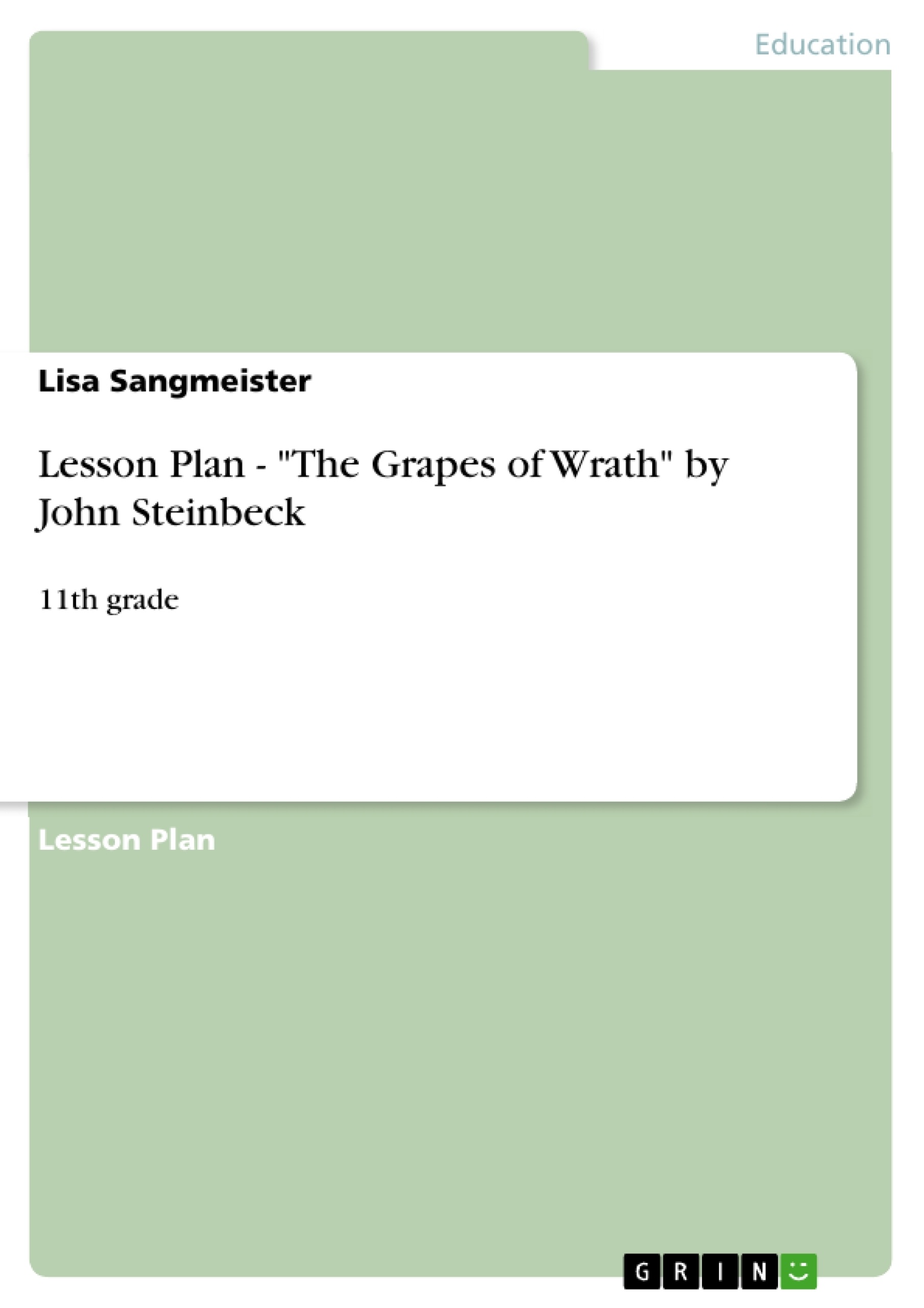1. General Overview
The Hessian Curriculum(1) demands that the English lesson in the Oberstufe has to improve the pupils’ language skills as well as enlarge their knowledge about English literature and different cultures. Correspondingly, the pupils should gain experiences with a variety of texts and different media. By this, they develop critical media literacy which is an essential prerequisite for working independently. Ideally, these main objectives should be combined
in every teaching unit.
The novel The Grapes of Wrath by John Steinbeck was published in 1939. It reports the story of the farmer family Joad which has, like hundred thousands of other families, to leave their home Oklahoma to start a new life in California. By this, Steinbeck exemplifies the fate
of migrant workers in the USA during the 1930’s. The novel should be motivating for the pupils as it constitutes an authentic documentation of the social circumstances during the time of the Great Depression.(2) Furthermore, the dramatic story of the family Joad is gripping and arouses empathy. The novel, moreover, refers to central topics, like work ethnic and inequality, which can be connected to the current problems of globalization.
In The Grapes of Wrath Steinbeck makes use of the migrants’ authentic language. That is why the reading might be a challenge for the pupils. Besides, Steinbeck’s literary techniques are note-worthy. He, for instance, adds so-called intercalary chapters, which evaluate the plot and provide further information on the historical context.
Moreover, the controversy(3) of the novel led to various reactions of artists and film adaptations. So the novel is an appropriate starting point for the comparison of different media, like for instance songs, photographs and film adaptations. Correspondingly, this teaching unit aims at combining knowledge about literature and history with the
development of language awareness and media competence.
__________
(1)Lehrplan Englisch, Gymnasialer Bildungsgang: Jahrgangsstufen 10G bis 12G, Hessisches Kultusministerium
2010 (Entwurf).
(2) John Steinbeck has accompanied migrant families on their way to California.
(3) At first, the novel was abolished in California, later it won the Pulitzer Prize (1940).
[...]
Inhaltsverzeichnis (Table of Contents)
- General Overview
- Main Objectives
- Unit Plan
- Introducing Remarks
- Necessary Equipment
- Concise Lesson Description
- Lesson 1
- Lesson 2/3
- Lesson 4
- Lesson 5/6
- Lesson 7
- Lesson 8/9
- Expectations
- Detailed Example Lesson
- Learner Description
- Subject Matter
- The Learners' Prerequisites
- Didactical Decisions
- Methodical Decisions
- Detailed Plan for one lesson
- Time
- Phase Order
- Minimal and Optimal Goals
- Projected Competencies
- Appendix
- Personal Evaluation
- Bibliography
Zielsetzung und Themenschwerpunkte (Objectives and Key Themes)
This lesson plan focuses on the teaching of John Steinbeck's novel "The Grapes of Wrath" in an advanced English course at the high school level. It aims to enhance students' language skills, broaden their knowledge of English literature, and cultivate critical media literacy. The unit is designed to be student-centered and action-oriented, incorporating diverse teaching methods to foster teamwork and develop cognitive and psychomotor skills.
- Analyzing the plot, character development, symbolism, and themes of "The Grapes of Wrath."
- Understanding the historical, social, and political context of the 1930s in the U.S. during the Great Depression.
- Improving reading skills, particularly skimming and interpreting colloquial language found in the novel.
- Developing critical media literacy through analyzing different media forms such as advertisements and films.
- Connecting the themes of "The Grapes of Wrath" to contemporary issues of globalization, work ethic, and inequality.
Zusammenfassung der Kapitel (Chapter Summaries)
The lesson plan provides a detailed breakdown of how to approach teaching "The Grapes of Wrath" over five weeks. It covers topics like plot development, literary elements, multi-media approaches, and a synopsis that bridges the results of the unit. The lessons are structured to encourage active student participation and analysis of the novel's key themes and stylistic choices. This includes using methods such as news flash creation, map-making, note-card discussions, hot seat exercises, analytical questions, group discussions, placemat activities, and personal essays or film sequences. The plan also includes resources like primary texts, secondary sources, film adaptations, and digital tools.
Schlüsselwörter (Keywords)
This teaching unit delves into the intricacies of "The Grapes of Wrath" by John Steinbeck, focusing on its narrative structure, thematic depth, and historical context. Key terms and concepts explored include: plot development, character analysis, symbolism, literary elements, the Great Depression, social inequality, work ethic, migrant workers, media literacy, film adaptations, and the use of colloquial language. This unit aims to equip students with the tools to engage critically with this impactful novel and its broader relevance within American literature and socio-economic history.
- Arbeit zitieren
- Lisa Sangmeister (Autor:in), 2010, Lesson Plan - "The Grapes of Wrath" by John Steinbeck, München, GRIN Verlag, https://www.grin.com/document/166099



